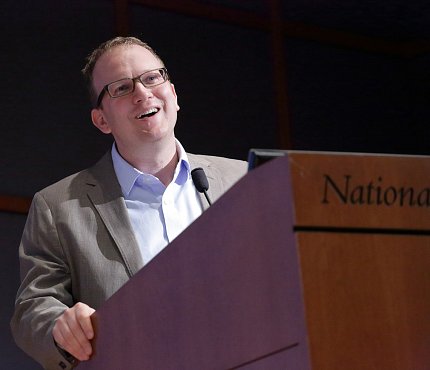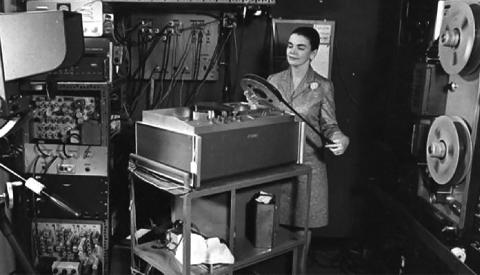Was this Revolution Televised?
History of TV Tech in Medicine Mined for 21st Century Lessons

Photo: Ernie Branson
When medicine met television in the mid-20th century, the subsequent wedding was one of necessity. Medicine at the time needed TV’s technology to reach remote, underserved areas and, potentially, disenfranchised patients. It was thought to be, perhaps, the dawn of a new era in medical care.
Dr. Jeremy Greene, a history of medicine professor at Johns Hopkins University, recollected that hope recently with two vignettes he told a Natcher Conference Center audience. What we can learn from the 60-year “telemedicine” marriage, he suggested, may help us navigate the early stages of today’s med-tech relationships—medicine via mobile device (“mHealth”) or vital sign monitors (“wearables”), for example.
“There is much in the story of medical images communicated by television in the 1960s and ’70s that is of relevance to contemporary understandings of new media in medicine and health today in the 21st century,” said Greene in his lecture, “The Analog Patient: Imagining Medicine at a Distance in the Television Era.”
His talk was the keynote of the National Library of Medicine’s 2-day “Images and Texts in Medical History: Workshop in Methods, Tools & Data from the Digital Humanities.”
Nothing New Under the Sun

Photo: Ernie Branson
“Claims for the ability of new media to inform the way we live in our bodies in health and disease are all around us,” Greene said. However, the promise also comes with “deep wells of anxiety.”
Hospital servers get hacked. Facebook, Twitter and email accounts get spoofed. Identity theft and privacy concerns get top billing these days. That’s today’s reality. But, as Greene pointed out, we’re not the first generation to run into roadblocks while trying to get the best medical help to those who need it.
“The challenge of diagnosing at a distance is not new to the 20th century—or even the 19th,” he said.
Tracking back to medieval times, Greene noted, mailed letters and drawings and other correspondence document the struggles of physicians back then seeking their faraway colleagues’ assistance in identifying and characterizing ailments.
It wasn’t until “the advent of closed-circuit and cable television in the late 1950s to the 1970s,” he explained, “that one finds an explosion of attention to the visual elements” sharable through electronic media.
To illustrate his point, Greene described the work of two “televisual visionaries”—Dr. Reba Benschoter and Dr. Kenneth Bird.
Doctor at a Distance

Photo: MASSACHUSETTS GENERAL HOSPITAL ARCHIVES AND SPECIAL COLLECTIONS
A pioneer in television medicine and biomedical communication, Benschoter was hired in 1957 by the Nebraska Psychiatric Institute (NPI) in Omaha to find ways to get health care to the state mental asylum in Norfolk, Neb.—112 miles away.
At a time when many leaders in the field were focused on TV mainly as a tool for health education, she began exploring “new uses of television as a more interactive medium, specifically by employing new technologies of closed-circuit TV and cable to link TVs to cameras at multiple locations and provide instantaneous visual communication,” Greene explained.
Head of NPI at the time, Dr. Cecil Wittson, who’d already had success designing telephone systems for medical use, devised a CCTV hookup between the two Nebraska institutions. With NIH funding, Wittson and Benschoter embarked on studies to test the practicality of their new interactive medium to provide expert care from a distance.
Benschoter presented early study results at the New York Academy of Sciences in 1966.
She and colleagues had been surprised. Although set up essentially to keep staff engaged with activities happening in Omaha, put medical residents in touch with mentors and hold joint grand rounds and telelectures, the CCTV system caught on in patient care.

Photo: MASSACHUSETTS GENERAL HOSPITAL ARCHIVES AND SPECIAL COLLECTIONS
At the time, the asylum did not have a neurologist on staff. Using the TV-camera device, though, a neurologist on site at NPI could observe detailed neurological exams and read EEGs remotely for patients at the asylum.
Patients also benefited more directly, Benschoter reported. Additional CCTV “viewing stations” were installed at both locations, so people hospitalized in Norfolk could visit in real time with their families back home in Omaha.
When the project ended in 1970, Benschoter and team concluded that the study was a success, largely because the inpatient population had dropped by half, from nearly a thousand patients before telemedicine to 476 post-CCTV.
Next Best Thing to Being There?
Greene next shared a story he called, “The Augmented Physician.”
On Oct. 4, 1960, a flock of starlings flew into the engine of an aircraft, causing a catastrophic plane crash in Winthrop Bay near Boston’s Logan International Airport. The pilots and many passengers perished on impact. However, a large number of people had survived the crash only to die critically injured, without medical attention.
Because of the location of the airport—less than 3 miles from Massachusetts General Hospital, but accessible only via an overcrowded highway system—emergency rescue and medical personnel could not reach the crash site.
The incident prompted Boston officials to establish an experimental medical station 3 years later at Logan’s gate 23 to respond to future airport emergencies. Cardiopulmonary internist Bird became the satellite hospital’s first director.
A follower of a writer Greene dubbed the “rock star of media studies,” Marshall McLuhan, Bird was keenly interested in “the broader problems of doctor shortages, limited accessibility to care and ways for new media to impact medicine.”
Pursuing new tech advances that could be used as “extensions of medicine,” he worked to connect his satellite hospital round-the-clock by telephone to the main hospital, essentially linking the outpost to 24-hour expert medical care.
Soon Bird realized that third-party phone descriptions weren’t always enough: Sometimes, physicians needed not only to hear but also to see patients. He successfully lobbied for an audiovisual “tele-diagnostic” clinic, which opened in April 1968. It was Bird who coined the term “telemedicine,” defining it as “the practice of medicine without the usual physician-patient physical confrontation, or the practice of medicine via interactive television.”
Let This Be a Lesson
Greene said both stories clearly show that medicine’s pathway to adapting and adopting new media has had twists and turns.
Benschoter and team faced misperceptions that telemedicine might one day effectively close down hospitals and put many doctors and nurses out of jobs. Bird tackled problems of logistics and privacy: how to design an effective TV signal that would not be picked up by casual receivers. Also, not everybody in potential patient populations was happy to accept the CCTV concept; some people chafed at the impersonal nature of health exams via television.

Photo: Ernie Branson
Despite the challenges, Benschoter and Bird continued successful careers developing biomedical communications. Both won more grants for further pilot structures and both later built broader systems in VA hospitals. Their perseverance, Greene said, serves as a lesson for this generation’s visionaries.
“The two episodes—one rural, one urban, one psychiatric, one somatic—did not go unnoticed by many, many others within public health and health policy at the time,” he concluded.
These pioneers did not chase “technology for technology’s sake,” Greene stressed, but sought advances that offered freedom from “an overly cumbersome health system that itself is perpetuating disparities by centering resources in a few institutions and urban settings.”
His conclusion about those historical innovators echoed the challenges of today’s trailblazing generation with its own struggles to reduce gaps in medical care, to reach underserved areas and to incorporate new tech into health care responsibly.
“Our current enthusiasm for the power of digital media and transforming the informational and health landscapes of the 21st century, our approach to diagnosis and therapeutics today, and our approaches to scholarship, data collection, analytic methods and new media for disseminating our findings—these all have strong historical precedents,” Greene said.
“Revisiting the history of the analog patient helps remind us that these new digital fascinations—for historians and physicians alike—all have parallels in similar encounters with analog media half a century earlier. Revisiting these older engagements of text and image in the history of medicine can open up a wealth of new research for all of these domains.”
The full lecture is archived at https://videocast.nih.gov/summary.asp?Live=18760&bhcp=1.
